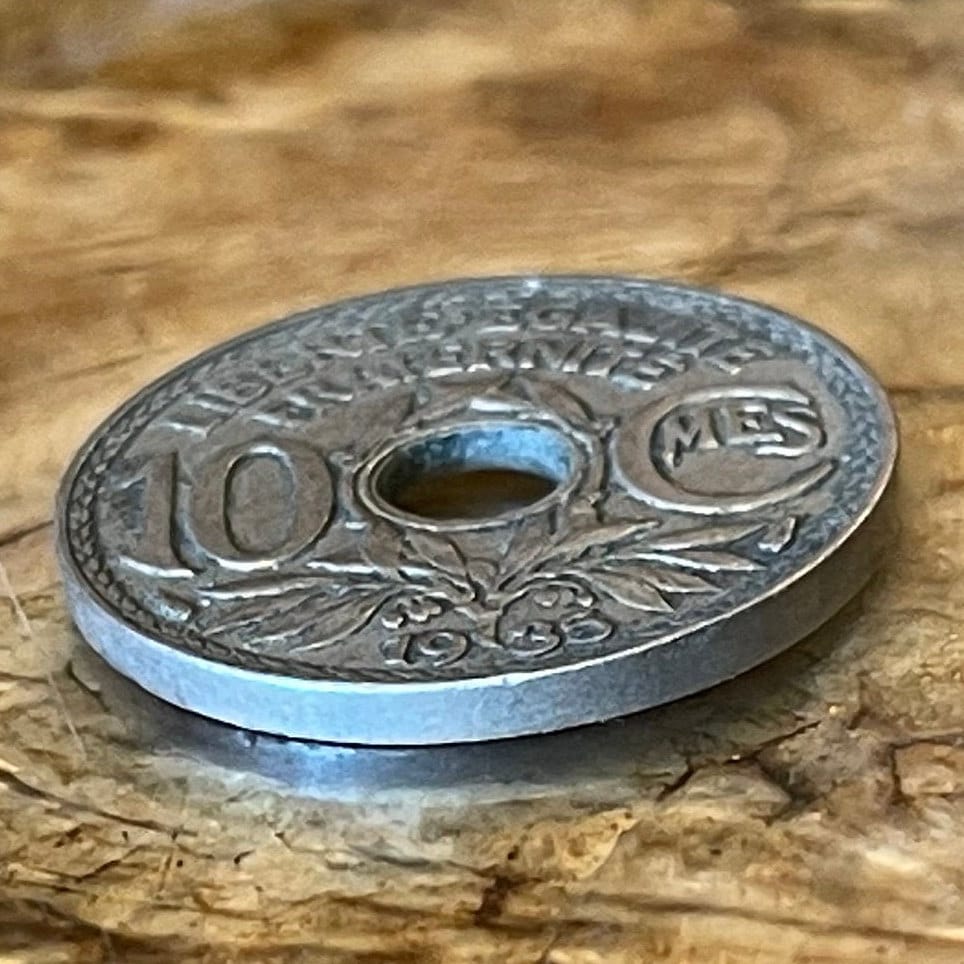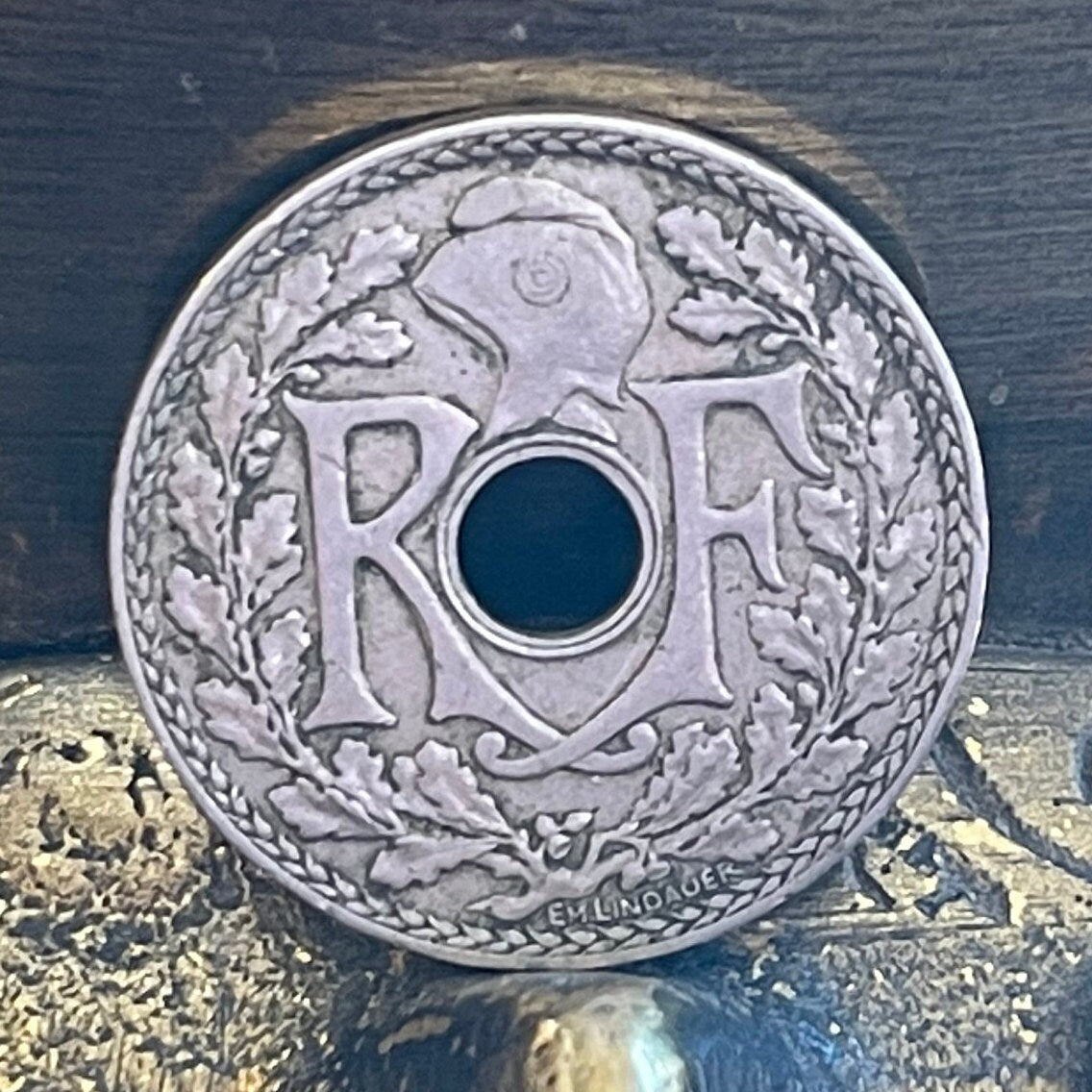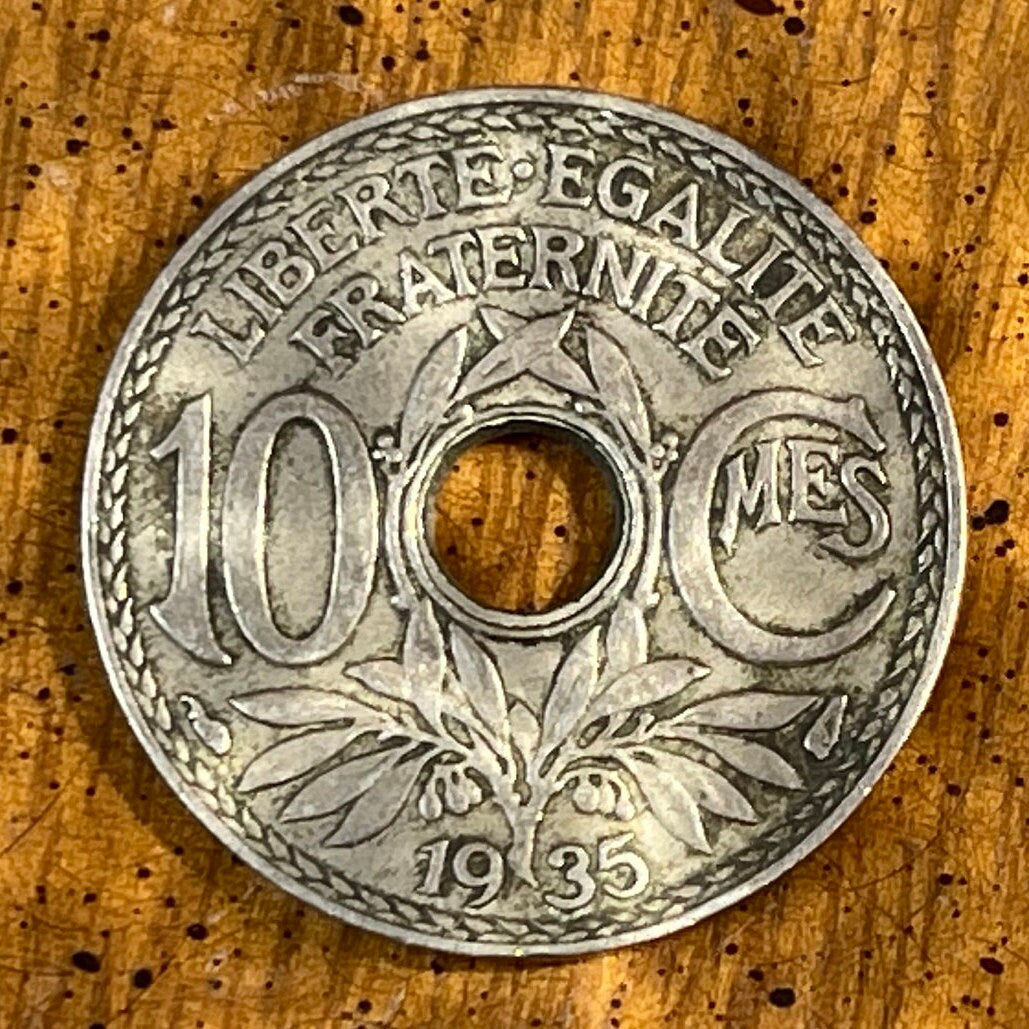elemintalshop
Olive Branch 10 Centimes France Authentic Coin Money for Jewelry and Craft Making (Peace) (Oak Leaves) (Liberty Cap)
Olive Branch 10 Centimes France Authentic Coin Money for Jewelry and Craft Making (Peace) (Oak Leaves) (Liberty Cap)
Couldn't load pickup availability
Liberty Cap & Olive Branch 10 Centimes France Authentic Coin Charm for Jewelry and Craft Making (Oak Leaves) (Peace)
Obverse: A wreath of Oak leaves. Phrygian liberty cap at the top with the letter R to the left of the central hole, letter F to right, the base of letters intertwined below. (Republique Francaise)
Translation: F[rench] R[epublic]
Reverse: Olive branch below the hole, date at the bottom. Lettering above the hole, value divided by hole, date at the bottom.
Features
Issuer France
Period Third Republic (1870-1940)
Type Standard circulation coin
Years 1917-1938
Value 10 Centimes (0.1)
Currency Franc (1795-1959)
Composition Copper-nickel
Weight 4 g
Diameter 21 mm
Thickness 1.68 mm
Shape Round with a round hole
Technique Milled
Orientation Coin alignment ↑↓
Demonetized 31 July 1947
Number N# 321
References F# 138, Gad# 286, Schön# 194a, KM# 866a
Lettering:
LIBERTÉ·EGALITÉ
FRATERNITÉ
10 CMES
Translation:
Liberty Equality
Fraternity
10 Centimes
********
Wikipedia:
The olive branch is a symbol of peace or victory allegedly deriving from the customs of ancient Greece, particularly regarding supplication to both the gods and persons in power and is found in most cultures of the Mediterranean basin. It became associated with peace in modern Europe and is also used in the Arab world. Despite claims of Ancient Greek origins, the symbol first appears in Ancient Egypt as a symbol of peace many centuries before appearing in ancient Greek mythology.
In Greek tradition, a hiketeria (ἱκετηρία) was an olive branch held by supplicants to show their status as such when approaching persons of power or in temples when supplicating the gods.
In Greek mythology, Athena competed with Poseidon for possession of Athens. Poseidon claimed possession by thrusting his trident into the Acropolis, where a well of sea-water gushed out. Athena took possession by planting the first olive tree beside the well. The court of gods and goddesses ruled that Athena had the better right to the land because she had given it the better gift. Olive wreaths were worn by brides[4] and awarded to olympic victors.
The olive branch was one of the attributes of Eirene on Roman Imperial coins. For example, the reverse of a tetradrachm of Vespasian from Alexandria, 70-71 AD, shows Eirene standing holding a branch upward in her right hand.
The Roman poet Virgil (70–19 BC) associated "the plump olive" with the goddess Pax (the Roman Eirene) and he used the olive branch as a symbol of peace in his Aeneid:
High on the stern Aeneas his stand,
And held a branch of olive in his hand,
While thus he spoke: "The Phrygians' arms you see,
Expelled from Troy, provoked in Italy
By Latian foes, with war unjustly made;
At first affianced, and at last betrayed.
This message bear: The Trojans and their chief
Bring holy peace, and beg the king's relief."
For the Romans, there was an intimate relationship between war and peace, and Mars, the god of war, had another aspect, Mars Pacifer, Mars the bringer of Peace, who is shown on coins of the later Roman Empire bearing an olive branch. Appian describes the use of the olive-branch as a gesture of peace by the enemies of the Roman general Scipio Aemilianus in the Numantine War and by Hasdrubal the Boeotarch of Carthage.
Although peace was associated with the olive branch during the time of the Greeks, the symbolism became even stronger under the Pax Romana when envoys used the olive branch as tokens of peace.
*********
Wikipedia:
The Phrygian cap (/ˈfrɪdʒ(iː)ən/) or liberty cap is a soft conical cap with the apex bent over, associated in antiquity with several peoples in Eastern Europe and Anatolia, including the Balkans, Dacia and Phrygia, where it originated. In first the American Revolution and then French Revolution, it came to signify freedom and the pursuit of liberty, although Phrygian caps did not originally function as liberty caps. The original cap of liberty was the Roman pileus, the felt cap of manumitted (emancipated) slaves of ancient Rome, which was an attribute of Libertas, the Roman goddess of liberty. In the 16th century, the Roman iconography of liberty was revived in emblem books and numismatic handbooks where the figure of Libertas is usually depicted with a pileus. The most extensive use of a headgear as a symbol of freedom in the first two centuries after the revival of the Roman iconography was made in the Netherlands, where the cap of liberty was adopted in the form of a contemporary hat. In the 18th century, the traditional liberty cap was widely used in English prints, and from 1789 also in French prints; by the early 1790s, it was regularly used in the Phrygian form.
It is used in the coat of arms of certain republics or of republican state institutions in the place where otherwise a crown would be used (in the heraldry of monarchies). It thus came to be identified as a symbol of republican government. A number of national personifications, in particular France's Marianne, are commonly depicted wearing the Phrygian cap.
**********
Liberté, égalité, fraternité (French pronunciation: [libɛʁte eɡalite fʁatɛʁnite]), French for "liberty, equality, fraternity", is the national motto of France, and is an example of a tripartite motto. Although it finds its origins in the French Revolution, it was then only one motto among others and was not institutionalized until the Third Republic at the end of the 19th century. Debates concerning the compatibility and order of the three terms began at the same time as the Revolution. The emphasis on Fraternité during the French Revolution led Olympe de Gouges, a female journalist, to write the Declaration of the Rights of Woman and of the Female Citizen as a response.
*******
Wikipedia:
The oak is a common symbol of strength and endurance and has been chosen as the national tree of many countries. ... In 2004 the Arbor Day Foundation held a vote for the official National Tree of the United States of America. In November 2004, the United States Congress passed legislation designating the oak as America's National Tree.
Other countries have also designated the oak as their national tree including Bulgaria, Cyprus (golden oak), Estonia, France, Germany, Moldova, Jordan, Latvia, Lithuania, Poland, Romania, Serbia, and Wales.
The prehistoric Indo-European tribes worshiped the oak and connected it with a thunder or lightning god, and this tradition descended to many classical cultures.
In Greek mythology, the oak is the tree sacred to Zeus, king of the gods. In Zeus's oracle in Dodona, Epirus, the sacred oak was the centerpiece of the precinct, and the priests would divine the pronouncements of the god by interpreting the rustling of the oak's leaves.
In Celtic polytheism, the name of the oak tree was part of the Proto-Celtic word for 'druid': *derwo-weyd- > *druwid-; however, Proto-Celtic *derwo- (and *dru-) can also be adjectives for 'strong' and 'firm', so Ranko Matasovic interprets that *druwid- may mean 'strong knowledge'. As in other Indo-European faiths, Taranis, being a thunder god, was associated with the oak tree.[61] "Tree" and drus may also be cognate with "Druid," the Celtic priest to whom the oak was sacred. There has even been a study that shows that oaks are more likely to be struck by lightning than any other tree of the same height.
In Norse mythology, the oak was sacred to the thunder god, Thor. Thor's Oak was a sacred tree of the Germanic Chatti tribe.
In Baltic and Slavic mythology, the oak was the sacred tree of Latvian god Pērkons, Lithuanian Perkūnas, Prussian Perkūns and Slavic Perun, the god of thunder and one of the most important deities.
The oak also appears in the Hebrew tradition. In the Bible, the oak tree at Shechem is the site where Jacob buries the foreign gods of his people (Gen. 35:4). Also, Joshua erects a stone under an oak tree as the first covenant of the Lord (Josh. 24.25–7). In Isaiah 61, the prophet refers to the Israelites as "Oaks of Righteousness". Absalom's long hair (2 Samuel 18:9) gets caught in an oak tree, and allows Joab to kill him.
Vereration of the oak survives in Serbian Orthodox Church tradition. Christmas celebrations include the badnjak, a branch taken from a young and straight oak ceremonially felled early on Christmas Eve morning, similar to a yule log. In recent times, only the branches are collected, brought home, and ceremoniously thrown into a stove or church bonfire. In another tradition, a zapis (lit. "inscription") is an old, isolated oak on a hilltop or promontory, often inscribed with a cross by a parish priest. Reverence for zapisi probably originated in pre-Christian times, and they long remained places of public gathering and even of Christian worship where churches were not available. For example, in 1815, at a zapis assembly in Takovo, knez Miloš Obrenović declared the start of the Second Serbian Uprising. Even in modern times, cutting down zapis oaks can result in public outcry, even for projects like road building.
In some traditions of Wicca, the Oak King is one of the two faces of the Sun God. He is born on Yule and rules from Ostara to Mabon.
Share









going to make into a little bracelet, and I hope people ask about it! It's subtle, but so perfect!!
Nice coins for building my foreign coin collection
Never disappointed with this seller. So many coins to choose from.
Item arrived in condition as depicted in photos.
5 stars review from Michele








